Thanks for your support! If you make a purchase using our links in this article, we may make a commission. And, as an Amazon Associate, I earn from qualifying purchases. See the full disclosure here.
Whether you are new to RVing or an experienced pro, you may wonder about boondocking and whether it is worth the effort. Boondocking is camping outside of a developed area or campground.
Most boondocking is dry camping, which means you will not have access to electric hookups, water, or a dump station. You also will not have the standard campsite features such as a picnic table.
So why would someone choose to boondock over staying in a campground? Our list of the pros and cons of boondocking will help you understand both the benefits and drawbacks of this style of camping.
RV Boondocking Pros
✅ Unlimited Campsite Space
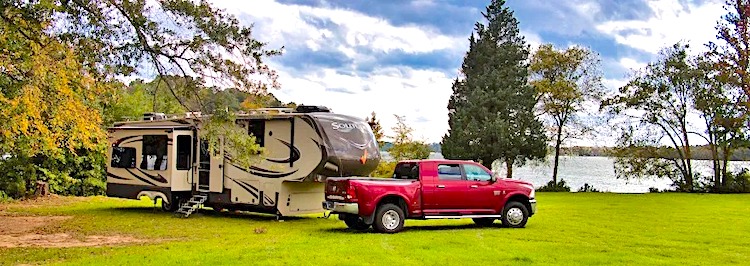
One of the most significant benefits of boondocking, in our opinion, is the space. We all know the experience of pulling in to a campground to find that the campsites have very little space. We’ve even stayed in some places where you could practically touch the RV next door from inside of our rig!
If you are looking for space to roam and explore, boondocking may be an excellent option for you. Since boondocking is typically done in undeveloped areas, you can choose your own place to camp, away from your neighbors if you like.
As long as you follow the restrictions of the public land, such as selecting a campsite only in designated areas, you can camp wherever you want.
Many people who are new to boondocking fall in love with it right away, due to the extra space alone!
✅ Privacy
Along with space, privacy is another wonderful bonus of boondocking. Often you will be the only person in the area, with no other people, homes or vehicles in sight!
The added privacy of boondocking is excellent if you want to truly get away from it all or use that outdoor shower! The privacy of boondocking makes it a unique experience when compared with camping in developed campgrounds.
✅ Unobstructed Views and Scenic Vistas
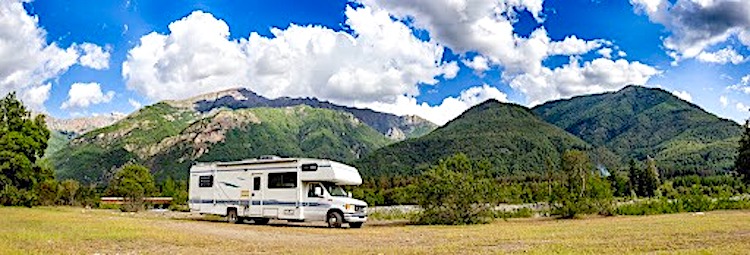
Our public lands are mostly undeveloped. The lack of development means that there will be no houses, tall buildings, or other human-created objects to interfere with your views when you are boondocking.
Some of the most fantastic campsite views we have ever experienced were found at boondocking locations. Whether you are gazing into an old-growth forest or taking in a scenic desert vista, you will be amazed at the views that you will have on your boondocking camping trip.
If you are looking for great boondocking locations with scenic views, they are not hard to find! The internet has made finding these locations even easier.
Try searching social media for hashtags such as #boondocking or #campsiteviews or use an app such as Campendium to view pictures of boondocking areas, along with the views.
Of course, you can always do it the old fashioned way and drive through your preferred public land camping area until you find the perfect view for you!
✅ Easy to Travel with a Large Group
If you have a group of friends that you enjoy camping with, boondocking can be an excellent option for your next camping adventure. Boondocking is an easy way to get everyone together without the complications of booking campsites months in advance or planning too far ahead.
To do this, choose a place to boondock and share the coordinates or directions with your group. The first person to arrive should look for an area large enough to accommodate everyone’s rigs. Many public land camping areas have room for twenty rigs or more in one shared space!
Keep in mind that if you plan to camp with friends, it is best to arrive around the same time and try to avoid arriving on a Friday or weekend if possible. The best areas will fill up quickly and may make it difficult for everyone to camp together.
If you can plan to arrive between Sunday and Thursday, it will make it easier to find a large spot to gather. Likewise, plan to arrive earlier in the day, before camping spots fill up for the night.
Remember to be a good neighbor and friend to your public lands. These campsites are first-come, first-served, so if your group has not arrived, it is not okay to “hold” spots for them.
✅ Boondocking is an Excellent Option for Camping with Kids
You may be surprised to hear that boondocking is an excellent option for families or anyone traveling with children. With the wide-open spaces and freedom to roam, boondocking is a real camping adventure for the young and young at heart.
Families are often relieved to know that they do not have to keep their children contained in a small space, away from other campsites when boondocking. Kids have more space to roam without disturbing others, and they can be as loud as they want!
✅ Boondocking is Often Near Great Recreational Opportunities
Public lands have a lot of offer in terms of camping and recreational opportunities. Many dispersed camping areas are near other great points of interest, such as hiking trails, biking trails, lakes, rivers, and more.
We have stayed on public lands with many excellent recreational opportunities, just steps away from the front door of our RV!
If you are seeking fun and adventure on your boondocking trip, check out the area to see what recreational opportunities are located nearby. You may be surprised at the many options you will have without leaving your campsite!
✅ RV Boondocking is Free
We saved the best for last! The biggest perk of boondocking is the low price: it is usually free! Nearly all dispersed camping on public lands is free of charge. You can camp for up to 14 days before you need to move to another area.
Being able to camp for free is a massive benefit of boondocking. Saving money on nightly camping fees frees up funds for activities, adventures, or you can simply keep the money in your bank account!
The Western United States has so many free camping areas that it is possible to travel for months or even years without paying to camp! The wide availability of public lands makes boondocking an excellent choice for anyone traveling long term or just trying to save some cash.
There are a few camping areas on public lands that charge a nominal fee, but it is rare. The fee in these locations is typically $7 per night. To determine if a camping area has a fee, you can check it out on the BLM or Forest Service website, or there will be a notice at the entrance to the camping area.
While it is unusual for dispersed camping on public lands to have a fee, it does happen. The bright side is that these areas usually offer some amenities in exchange for the fee. Toilets and picnic tables are typical features of these camping areas.
RV Boondocking Cons
⛔️ Camping Spots Can Be Hard to Get To
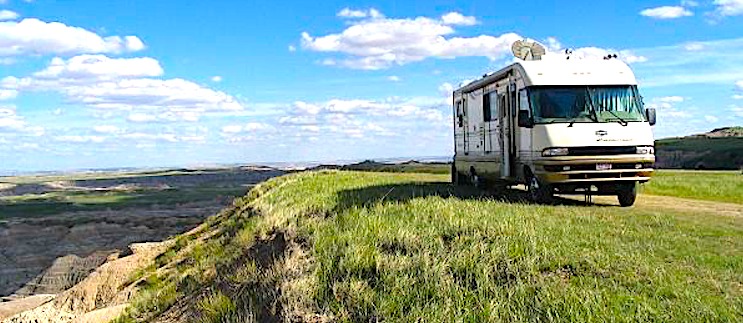
While we have seen rigs of all sizes in even the most remote boondocking locations, good dispersed camping can undoubtedly be challenging to get to, especially with a larger rig. If you have a travel trailer, a four-wheel-drive vehicle may be necessary in order for you to access some areas.
The key to avoiding an unpleasant mishap (or worse) is to do your research in advance. Ask other campers and check with rangers about conditions in the area in which you plan to camp.
When you arrive at your dispersed camping area, pull over and walk the road. Make sure that you can safely navigate it with your rig. If you have any doubts, turn around.
⛔️ No Amenities
One of the most significant differences between boondocking and camping in a campground is the lack of amenities. Most dispersed camping is little more than a dirt or gravel turnout. Occasionally, but not always, you may have a fire pit.
When compared to the amenities of even the most basic of campgrounds, dispersed camping is undoubtedly lacking.
If you are used to the comforts of an RV resort, boondocking will be a significant change from what you are used to. In exchange, you will get peace, quiet, and privacy, which is an excellent trade-off!
⛔️ Remote Location
Often, but not always, boondocking spots are in remote areas. In many cases, you may be 20 to 30 minutes or more from the nearest town. You may or may not have cell service when you are boondocking. All of this could be a pro or a con to you, depending on your preferences.
Your location is definitely something to take into consideration before you decide on a boondocking site. Although most dispersed camping is found in more remote areas, we have found that many great spots are relatively close to small towns, and many even have excellent cell service!
Again, research is vital here. Check with other campers, rangers, and online camping sites to get an idea of the area so that you know what to expect. While you should always plan to go without cell service, you will often be pleasantly surprised at the coverage that you will have.
⛔️ You Can’t Make a Reservation
Dispersed camping is first-come, first-served. The flexibility of boondocking can be great if you are willing to be spontaneous, but it can be frustrating if you plan to camp in a specific area and find it to be full of other RVers.
If you want to be in a specific camping area, the best thing to do is arrive early in the day when other campers are preparing to leave their campsites. Arriving around 10 a.m. or midday will usually give you more chances at snagging a great spot.
Arriving at a popular camping area late on a Friday evening or anytime on a Saturday almost always guarantees disappointment. If the area is popular, it may be impossible to get a space to camp. To play it safe, plan ahead, and always have a backup plan just in case.
⛔️ You Must Provide Your Own Water and Essentials
If you plan to camp in a dispersed camping area for more than one night, you will need to do some planning in advance to make sure you have everything you need. Make sure you have enough water for each person in your group for the length of your trip.
You will want to be sure you have food and everything you need to prepare meals or plan to make a lot of trips into town!
While this is not much different than tent camping, it can be a change for anyone used to camping in a more populated area. However, with a little thought and preparation, you can have a great time in the wilderness!
⛔️ No Hookups
Going without hookups is probably the biggest challenge of boondocking. While most people can go a night or two without electricity, doing without it for days on end can be a challenge.
There are some workarounds for this, including purchasing a generator or solar panels for your rig. Most frequent boondockers have either a generator, solar panels, or both, which can make dry camping much more pleasant.
Not being able to dump your tanks on site is another concern. If you plan to boondock for multiple days at a time, you will need a plan for dealing with your waste.
Remember that it is illegal to dump your black tanks on public lands. Some areas will allow you to dump gray water, but other areas may not. Be sure to check the regulations in advance or be prepared to dump your gray water elsewhere.
The best option for dumping your tanks when dry camping is to find an RV dump station close to your location. You can find dump stations at many gas stations.
Private campgrounds or state parks will usually allow you to dump your tanks for a small fee. While this can be a hassle, many boondockers find dumping their tanks to be a minor inconvenience compared with the benefits of free camping.
RV Campground Pros
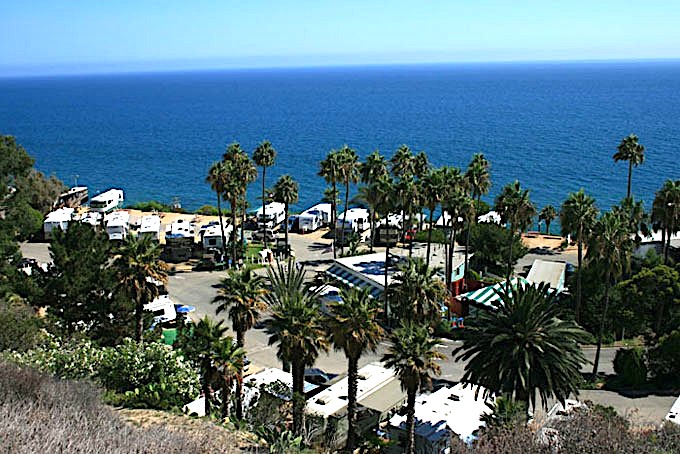
✅ You Can Make Reservations
Many people prefer the ease of campgrounds, especially when it comes to reservations! If you are traveling a long distance, or have a specific destination in mind, you may want to have a campsite reserved.
Reservations can be especially essential on the weekends or during busy summer months. The peace of mind that comes with knowing you have a site reserved just for you is a big plus of staying in a campground.
✅ Hookups, Bathrooms, and Showers!
Camping is fun, but it can also be a lot of work! Staying in a campground with full or partial hookups eliminates a lot of this work and allows more time for fun. While it does come with an added expense, hookups are an absolute must for many RVers.
Campgrounds also typically offer bathhouses, which are popular with campers. Many people prefer camping in a developed campground so that they can access a “real” shower instead of the shower in their RV.
It is wise to consider your personal preferences when deciding whether to boondock or stay in a campground.
✅ Amenities and Activities
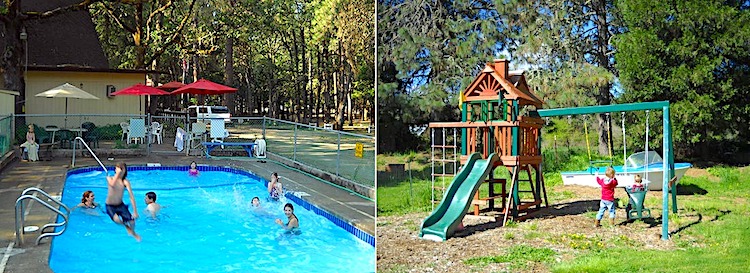
Along with hookups, many developed campgrounds also offer a variety of amenities and activities. From pools to tennis courts, BINGO games to ice cream socials, you will find a wide range of activities at state and national parks as well as private RV parks.
There is also usually a small campground store on site which can be helpful if you forget a needed item during your stay.
For many people, these amenities and activities are a big part of their enjoyment of the camping experience. Other people may not use these facilities at all! It is up to you to decide how much you value organized events and recreational opportunities during your camping vacations.
✅ RV Campgrounds are Often Near Desired Areas
If you are traveling to a specific point of interest, you will usually find many developed campgrounds located nearby.
Most major cities, beaches, and national parks offer a wide variety of campground options in the surrounding area. Having major attractions close by makes developed campgrounds very convenient during your getaway.
✅ Campground Staff on Site
One final benefit of staying in a campground is the ease and convenience of having staff on site. Campground staff makes sure that everyone is respecting the rules of the campground, including keeping down the noise.
They also can help you with any issues that may arise and keep the campground looking clean and fresh. Finally, campground staff can be an excellent resource for finding fun things to do in the area.
RV Campground Cons
⛔️ Small Campsites

While most state and national park campground campsites offer some degree of space, many private campgrounds do not. Often, spaces are very close together. If you want more space, you may have to pay an additional fee for a larger campsite.
Lack of space is one of the most significant drawbacks of camping in a private campground. One way to ensure that the campground you choose has enough space between sites is to check out photos of the campground and campsites in advance.
We use campsitephotos.com to take a look at campgrounds and see if the sites are too close together for our comfort.
⛔️ Little to No Privacy
It is rare to find a private campground that offers any privacy for campers. Most private campgrounds have spaces close together with few trees.
The close proximity of other campsites makes it challenging to kick back and relax as your neighbors may be doing the same thing within just a few feet of you!
State and national park campgrounds typically have a little more space between spots, which affords you a bit more privacy. While some private campgrounds are better than others, do not expect to be far from your neighbor in these locations.
Checking out campsitephotos.com is an excellent way to see the space and privacy available at each site. Keep in mind that not all campsites are the same- there are usually some sites in each campground that are better than others.
A few minutes of research before booking can lead to a much more pleasant stay for you and your family.
⛔️ Reservations are Often Needed Far in Advance
Many times we have been disappointed to plan a last-minute camping trip, only to find that the campground we preferred is book solid. As RVing grows in popularity, campgrounds are often filling, making it difficult to secure a reservation, even months in advance.
With boondocking, no reservations are needed, making it a more flexible option for those traveling last minute or anyone seeking some spontaneity in their lives.
⛔️ RV Campgrounds Can Be Expensive
While campgrounds often have great amenities and features that make them more comfortable than boondocking, these bonuses come at a price. The more amenities at the campground, the higher the cost.
Most state and national parks charge anywhere from $15 to $30 per night. This fee usually includes access to a bathhouse, picnic table, and fire ring. Some state parks offer hookups in their rates as well.
Private campgrounds can cost anywhere from $30 or more per night. We have seen some private campgrounds in peak season that cost more than $100 per night! This cost can quickly add up!
Keep in mind that the more expensive campgrounds do typically offer more amenities. Full hookups, WiFi, cable, pools, and recreational opportunities are often included at the pricier resorts. Be sure to take a look at all the amenities to see if the campground you are considering is worth the cost.
What About Safety?
Many people avoid boondocking out of safety concerns. There is a fear that if you are alone along a remote road, something could happen, and there would be no one around to help or respond.
You may be surprised to learn that many people who boondock report feeling safer while boondocking as opposed to a campground. We all know that crime could happen anywhere, and in fact, petty theft takes place in campgrounds as well as neighborhoods.
Fewer people around means fewer crimes of opportunity, although locking your doors and keeping an eye on your valuable items is a best practice no matter where you camp.
If you are worried about emergency response in the event of a health issue or accident, you can take steps to reduce this concern. Make sure you have cell service or at least be aware of how far you will have to drive to make a call.
Write down your physical location and make a note of the nearest hospital or emergency response team. All of these steps can help to reduce your fears, whether you are in the wilderness or a busy campground.
How Can I Find Places to Boondock?
The best places to boondock throughout the United States are on public lands. For the most part, these lands are free or very low cost for use by visitors and travelers.
The two most common types of public lands in the United States are the Bureau of Land Management, or BLM land, and land managed by the United States Forest Service.
Bureau of Land Management
Bureau of Land Management land is mostly found in the Western United States. While much of the land is more remote, there are many areas available for camping that are close to population centers, national parks, and other areas that are perfect for camping and exploring.
An example of excellent BLM camping land can be found in and around Moab, Utah. This area is extremely popular and often feels more like a campground with lots of other campers close by on the weekends.
However, the vast majority of this camping is totally free, and it is within a twenty-minute drive of Arches National Park and also convenient to Canyonlands National Park and Capitol Reef National Monument. Another great benefit is that the views are spectacular!
When camping on BLM land, you will not find the picnic tables and restroom facilities that you would expect in state and national parks. Instead, you will find dispersed camping with wide, open spaces.
Dispersed camping means that you will need to bring your own water, trash bags, and other necessities. You will need to be prepared to go without electric hookups and restrooms as well.
Before setting out for BLM land, make sure you have everything that you need for your stay. While you are there, you will need to follow the “leave no trace” principles. Pack out your trash, bury any human waste, and leave your camping area as you found it.
Dispersed camping is allowed on most BLM land for up to 14 days. While most BLM land is free, some more popular areas do charge a small fee, typically $7 per night.
While a nightly camping fee is rare on public land, if you do camp in areas where the fee is required, be sure to do the right thing and pay upon arrival or risk a fine or ticket.
Finding the Bureau of Land Management lands can be a challenge. The BLM website does not offer a comprehensive map of the United States, but they do have regional maps available online.
You can also reach out to the BLM office to get more information on the land available for camping. Some states have guidebooks for BLM camping, which you can find either online or at local offices. We use the app Campendium to find great BLM camping areas.
United States Forest Service
Another great option is land managed by the United States Forest Service (USFS). Forest Service land is undeveloped, but camping along turnouts and in dispersed areas is permitted. There are over 175 forest and grassland areas where campers are welcome to camp for free.
The maximum amount of time you can camp on Forest Service land is 14 days. Be sure to follow these guidelines as rangers do keep an eye on campers and will ask you to move along after the two week period has elapsed. Again, like with BLM land, you will need to bring all of your necessities and be sure to leave no trace.
Similar to the Bureau of Land Management, the Forest Service does not have a comprehensive guide for locating these lands. There are several excellent options for finding these areas on your own. First, check with each ranger district directly. If you know where you plan to visit, you can check for forest lands in that area.
Another great option is to utilize the United States Forest Service website. The website allows you to search by state for forest land in that area. Then, you can check the web page for the specific forest or grassland for camping information.
The easiest way to find forest service land open for camping is to use an app, such as Campendium. With Campendium, you can search for free campsites, which will bring up a list of all public lands in your area.
– What is BLM Camping?
– 8 Easy Ways to Get Water When Boondocking
– RV Boondocking Beginner Tips and “How-To” Guide
– Best Places to Go RV Camping for FREE
Conclusion
Boondocking certainly isn’t for everyone but neither is staying in an RV campground. But we hope after reading through RV Campgrounds vs Boondocking: Pros and Cons you will have a better understanding of both types of RV Camping so you can make the best decision for you and your family.
Mike Scarpignato – Bio
Mike Scarpignato created RVBlogger.com over five years ago in 2018 to share all we have learned about RV camping.
Mike is an avid outdoorsman with decades of experience tent camping and traveling in his 2008 Gulf Stream Conquest Class C RV and 2021 Thor Challenger Class A motorhome.
We attend RV Shows and visit RV dealerships all across the country to tour and review drivable motorhomes and towable trailers to provide the best evaluations of these RVs in our blog articles and YouTube videos.
We are 3/4-time RVers who created RVBlogger.com to provide helpful information about all kinds of RVs and related products, gear, camping memberships, tips, hacks and advice.


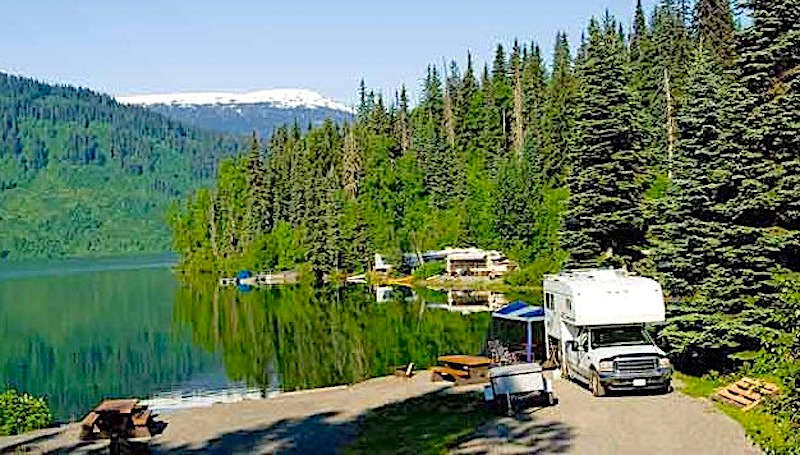

We have done some boondocking but not as much as we have thought. The popular outdoor areas can be just as crowded as a campground and I would rather pay and have amenities at that point if it’s going to be crowded. Also we have run into unsavory and lots of homeless on our boondocking times and usually but not always when you pay you do not find those kind of people at campgrounds where you pay. We also know that our RV is a recreational vehicle not designed to live in and daily use of our plumbing and electrical systems can be hard on them and can be costly and difficult to fix. By staying in campgrounds and paying we are able to shower snd use their bathroom facilities saving ours from wear and tear. We are now very careful where we decide to boondock and only do it for a night or two. We have actually found fairgrounds to be quite pleasant with usually water and electric hook ups with a dump station and decent bathrooms. They are usually just outside of a town and close to stuff just not in stunning settings but we have usually only paid $12!
Hi Jamie,
Thanks for sharing your experience and also for the tip about boondocking at fairgrounds!
Mike
It’s good to know that with boondocking you can camp and explore. I want to move into an RV with my kids so we can travel. I’d love to find a mixture of RV parks and spots to boondock!
Hi Eve,
Finding a mixture of boondocking and campgrounds is a great mix. That’s what we do so we can boondock a few days then stay in a campground and dump our tanks and refill water etc.
Thanks for reading!
Mike